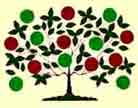|
The Shaker religion has its roots
in a small group of radical Quakers that were active in Manchester, England
in the 1760’s. The group was led by James and Jane Wardley who were viewed by the group members as a prophet and prophetess.
During this time the Wardley’s and the other members were joined by a young woman by the name of Ann Lee who would soon
become known as Mother Ann, the founder of the American Shakers. During the late 1760’s and early 1770’s, Ann
Lee and her fellow Shakers were often persecuted for their religious beliefs. Ann Lee herself was arrested several times and
on several other occasions was physically threaten by mobs. In 1774, Ann Lee and a handful of other Shakers made the decision
to leave England in favor of North America
which held the promise that they would be able to practice their religion freely. Records as to when the Shakers from England actually settled just north of Albany, New
York are vague until 1779 when the Shakers once again surface in contemporary records as landholders in Niskeyuna, New York which is now known
as Watervliet.
May 19, 1780, known as the Dark
Day due to the fact that the sun reportedly did not shine, most likely caused by smoke from a fire, marks the day of the first
recorded public testimony of the American Shakers. From this point onward the Shaker faith began to grow. Among the early
Americans to join the Shaker community was a man by the name of Joseph Meacham who would with the closing of the age of the
founders become an influential leader. The age of the founders in the early years in America were filled with a steady growth of the religion as Ann Lee broke out of
the secular tradition of isolation by traveling extensively, spreading her beliefs. In July of 1784 one of the key leaders,
William Lee, died. His death was followed just two months later by the death of Ann Lee. Leadership of the young community
was then left to James Whittaker. It was during this time that the Shakers began to engage in their practice of communalism.
By combining their resources and assets, they were able to build their first meeting house in New Lebanon, which was raised
on October 15, 1785. Under the leadership of Whittaker, the community made great strides in establishing a sense of community
and ability to stand the test of time. The Age of the Founders came to an end with the death of Whittaker in 1787.
With the death of the last founder,
leadership of the community fell to Joseph Meacham who had been one of the first American converts. Meacham was responsible
establishing much of the organization and structure for which the Shakers are known for today. He was influential in developing
the hierarchical structure not only within individual Shaker families but also within the larger sphere of Shakerism. It is
from this structure that the central ministry is derived. Meacham was also influential implementing the first written covenant
as well as the development of a set of rules and regulations which indicated proper Shaker behavior. These rules would eventually
become known as the Millennial Laws of 1821. “The Millennial Laws evolved out of the practical needs of the growing
society, but they accomplished more than simply regulating daily activities. They also defined the boundaries between Shakerism
and the world”.[i]
Yet another way that Joseph Meacham
contributed to the development of Shakerism, as it is known today, was advocating for the continuation of female leadership
within the community. When choosing his partner in the ministry, he selected a female convert by the name of Lucy Wright.
Upon his death Wright became the principal leader of the now organized Shaker society. The ministry of Lucy Wright corresponded
with the expansion of the Shaker belief. By the time of her death in 1821 the Shaker communities stretched from South Union,
Kentucky to New Gloucester, Maine. With the death of Wright’s successor, David Darrow, four years later, the formative
period of the Shakerism drew to a close.
[i] Stephen J. Stein, The Shaker Experience
In America (New Haven: Yale University Press, 1992), 95.
|

